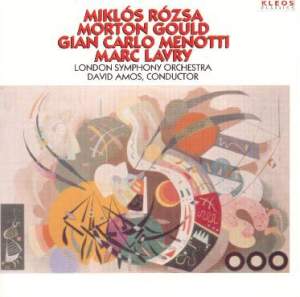Not containing music written for the cinema, this album is of associational interest for Film Music on the Web. Although three of the four composers represented have written for the screen, I think it is fair to suggest that the main interest for many will be the opening concert work by Miklós Rózsa, the Tripartita for Orchestra, op. 33. However, if listeners never got any further than this they would be missing out on some excellent music of a sort which will surely appeal to lovers of 'classic' film composition.
In that there is no particular connection between the four composers featured here, this is an unusual album. However, one could draw the connection that all pieces here are the works of 20th Century composers who have drawn on earlier, pre-existing folk or classical traditions for their inspiration. Given that the back cover states 'Previously released material', but then offers no further explanation, it seems obvious that these pieces were not originally released together. No recording dates are given, though we are also told that this is 'An original digital recording'. All the music is performed by the London Symphony Orchestra under the baton of David Amos. Other than the fact that all four composers were born within 11 years, between 1903 (Marc Lavry) and 1913 (Morton Gould), the only other reason given for this music being presented on the same disc is the statement that "David Amos has made it his speciality as an orchestral conductor to introduce to the public works of modern composers worthy of greater recognition."
Miklós Rózsa's Tripartita for Orchestra dates from 1972, and is composed in a style immediately recognisable by anyone familiar with Rózsa's film work. Consisting of an 'Intrada', 'Intermezzo Arioso' and 'Finale', here is 21-minutes of concentrated musical fury, an explosive eruption of colour which offers little let-up and no real promise of resolution. With pulsating motor rhythms familiar from the great film noirs / thrillers Rózsa made with producer Mark Hellinger (The Killers, Brute Force, The Naked City,) the music races from one biting climax to the next, only relaxing the tension in the intermezzo to paint a darkly haunted landscape with roots in the folk music of the composer's beloved homeland, Hungary. There is some fine violin playing from Ashley Arbuckle.
The booklet notes would have one believe Morton Gould was born in 1939, but wrote his Folk Suite the previous year. In-fact the composer was 25 when he composed the piece - an 'Overture', 'Blues' and a final 'Jig' - created at much the same time Aaron Copland was 'inventing' the sound of modern Americana, a sound which would influence untold Westerns. Like Copland's famous ballets Billy the Kid
and Rodeo, Gould's suite is written in a variety of folk-idioms, yet unlike Copland, his work consists entirely of original tunes. Alongside the music Virgil Thomson was writing for such films as The Plough that Broke the Plains (1936), Gould's work proves that Copland alone didn't create our aural image of the West. His central 'Blues' may evoke Gershwin, while the finale is a 'Jig' of exhilarating proportions. Gould would eventually go on to write for the screen, composing some of the music for Cinerama Holiday (1955), and much later scoring Holocaust (1978), one of the first significant American mini-series.
Gian Carlo Menotti can hardly be considered a film composer, though his television opera Amahl and the Night Visitors, has been produced at least three times, in 1951, 1963 and 1978. Menotti's early life had much in common with that of the great film composer Nino Rota. Both were Italians born in 1911 and were remarkable prodigies, Rota composing his oratorio The Childhood of John the Baptist at the age of 11, Menotti having two operas to his name by the age of 13. Both then studied in Milan and both wrote works influenced by the music of the Renaissance. Menotti's delightful Triplo Concerto a Tre, commissioned by Stokowsky in 1970 is one such piece. Offering lyrical solo writing for woodwinds against string trio and piano, this is music which will give much pleasure to anyone who enjoyed the two recent collections of Nino Rota's chamber music.
That by the Ensemble Nino Rota and that by
the Ex Novo Ensemble In short, Triplo Concerto a Tre is a lyrical gem.
Marc Lavry's Emek-Symphonic Poem dates from 1936, and when chosen by Leonard Bernstein for his first American tour with the Israeli Philharmonic in 1950, became associated in the West with the energetic optimism of the youthful State. Programmatic in nature, Lavry was inspired by the pioneer workers in the Emek valley, struggling daily to drain the swamps then celebrating with song, dance and romance at night. The Poem follows one typical such day, slow-building landscape music which develops into a thrilling, ever accelerating hora dance. In much the same way Miklós Rózsa drew on the folk music of Hungary, the album closes with music derived from the Jewish folk tradition.
All four works on this album are written in accessible, tonal idioms. They are full of melody and excitement and there is no reason why they should not all appeal to discerning lovers of good film music. The sound is excellent and the performances both vigorous and polished. A rewarding release slightly let down by less than full documentation.**** Gary S. Dalkin
Gary S. Dalkin





